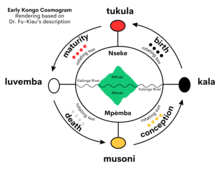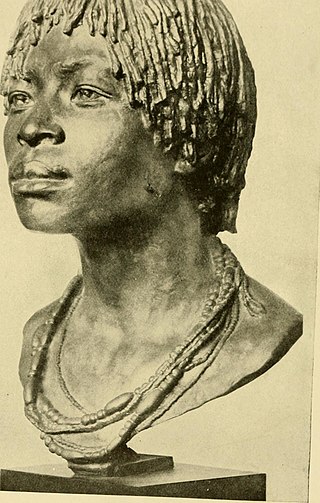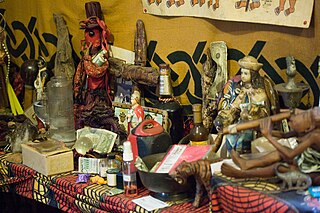
Mfinda is a spiritual concept of the forest in Kongo religion.

Mfinda is a spiritual concept of the forest in Kongo religion.
Nature is essential to Kongo spirituality. While simbi (pl. bisimbi) nature spirits later became more associated with water, or kalûnga, they were also known to dwell in the forest, or mfinda (finda in Hoodoo). The Kingdom of Kongo used the term chibila, which referred to sacred groves, where they would venerate these forest spirits. The Kingdom of Loango called them bakisi banthandu, or spirits of the wilderness. [1] The Kingdom of Ndongo preferred the name xibila (pl. bibila). [2]
The Kongo people also believed that some ancestors inhabited the forest after death and maintained their spiritual presence in their descendants' lives. These particular ancestors were believed to have died, traveled to Mpémba, and then were reborn as bisimbi. Thus, The Great Mfinda existed as a meeting point between the physical world and the spiritual world. The living saw it as a source of physical nourishment through hunting and spiritual nourishment through contact with the ancestors. One expert on Kongo religion, Dr. Fu-Kiau, even described some precolonial Kongo cosmograms with mfinda as a bridge between the two worlds. [1]
Mfinda is also where Kongo secret societies, such as Kinkimba and Lemba, initiated new healers. Expert healers, known as banganga (sing. nganga) underwent extensive training to commune with the ancestors in the spiritual realm and seek guidance from them. These new initiates learned how to locate nature spirits and build a connection. Once they became official banganga, it became their duty to seek them out in the forest and venerated them with shrines, sacred trees, and minkisi (sing. nkisi). In return, the ancestor or nature spirit would pass on untold history, advise the nganga, or allow them to harness their powers for healing or protection. [1]
The concept of mfinda as a spiritual space also emerged in the colonial United States through trans-Atlantic slavery and became known locally as finda. Bakongo descendants saw the wilderness as a symbol of freedom but also sorrow. Because early enslaved Bakongo had no ancestors on this side of kalûnga (which became synonymous with the Atlantic Ocean), it meant they had no blood tie to the new lands in which they were transported. [1] Thus, banganga had no way to connect to the spiritual world. To remedy this, some Bakongo and Mbundu willingly committed acts of sacrificial suicide so that they could become ancestors or simbi and connect the living to Mpémba, the spiritual world. The finda then became a sacred space, where sightings of "cymbee" spirits were often recorded by Black Americans. Today, the finda is still a significant element in Hoodoo. [1]
A mojo, in the African-American spiritual practice called Hoodoo, is an amulet consisting of a flannel bag containing one or more magical items. It is a "prayer in a bag", or a spell that can be carried with or on the host's body. Alternative American names for the mojo bag include gris-gris bag, hand, mojo hand, toby, nation sack,conjure hand, lucky hand, conjure bag, juju bag, trick bag, tricken bag, root bag, and jomo. The word mojo also refers to magic and charms. Mojo containers are bags, gourds, bottles, shells, and other containers. The making of mojo bags in Hoodoo is a system of African-American occult magic. The creation of mojo bags is an esoteric system that involves sometimes housing spirits inside of bags for either protection, healing, or harm and to consult with spirits. Other times mojo bags are created to manifest results in a person's life such as good-luck, money or love.
A creator deity or creator god is a deity responsible for the creation of the Earth, world, and universe in human religion and mythology. In monotheism, the single God is often also the creator. A number of monolatristic traditions separate a secondary creator from a primary transcendent being, identified as a primary creator.

A Simbi is a water and nature spirit in traditional Kongo spirituality, as well as in Hoodoo.

Hoodoo is a set of spiritual practices, traditions, and beliefs that were created by enslaved African Americans in the Southern United States from various traditional African spiritualities, Christianity and elements of indigenous botanical knowledge. Practitioners of Hoodoo are called rootworkers, conjure doctors, conjure man or conjure woman, root doctors, Hoodoo doctors, and swampers. Regional synonyms for Hoodoo include conjure or rootwork. As a syncretic spiritual system, it also incorporates Islam brought over by enslaved West African Muslims and Spiritualism. Scholars define Hoodoo as a folk religion. Folk religions are syncretic traditions between two or more cultural religions, in this case African indigenous spirituality and Abrahamic religion.

The Kongo people are a Bantu ethnic group primarily defined as the speakers of Kikongo. Subgroups include the Beembe, Bwende, Vili, Sundi, Yombe, Dondo, Lari, and others.
Palo, also known as Las Reglas de Congo, is an African diasporic religion that developed in Cuba during the late 19th or early 20th century. It arose through a process of syncretism between the traditional Kongo religion of Central Africa, the Roman Catholic branch of Christianity, and Spiritism. Initiates in the religion are termed paleros (male) or paleras (female).

Nkisi or Nkishi are spirits or an object that a spirit inhabits. It is frequently applied to a variety of objects used throughout the Congo Basin in Central Africa, especially in the Territory of Cabinda that are believed to contain spiritual powers or spirits. The term and its concept have passed with the Atlantic slave trade to the Americas.

A jengu is a water spirit in the traditional beliefs of the Sawabantu groups of Cameroon, like the Duala, Bakweri, Malimba, Subu, Bakoko, Oroko people. Among the Bakweri, the term used is liengu. Miengu are similar to bisimbi in the Bakongo spirituality and Mami Wata. The Bakoko people use the term Bisima.

The Kalûnga Line in Kongo religion is a watery boundary between the land of the living and the spiritual realm of the ancestors. Kalûnga is the Kikongo word "threshold between worlds." It is the point between the physical world and the spiritual world. It represents liminality, or a place literally "neither here nor there." Originally, Kalûnga was seen as a fiery life-force that begot the universe and a symbol for the spiritual nature the sun and change. The line is regarded as an integral element within the Kôngo cosmogram.
Soul dualism, also called dualistic pluralism or multiple souls, is a range of beliefs that a person has two or more kinds of souls. In many cases, one of the souls is associated with body functions and the other one can leave the body. Sometimes the plethora of soul types can be even more complex. Sometimes, a shaman's "free soul" may be held to be able to undertake a spirit journey.

Louisiana Voodoo, also known as New Orleans Voodoo, is an African diasporic religion that originated in Louisiana, now in the southern United States. It arose through a process of syncretism between the traditional religions of West Africa, the Roman Catholic form of Christianity, and Haitian Vodou. No central authority is in control of Louisiana Voodoo, which is organized through autonomous groups.

Banganga are spiritual healers or ritual specialists in Kongo religion. These experts also exist across the African diaspora in countries where Kongo and Mbundu people were transported during trans-Atlantic slavery, such as Brazil, the southern United States, Haiti and Cuba.

Nyambe is the Supreme God, Sky Father, and God of the Sun across numerous traditional Bantu religions.

Bantu religion is the system of beliefs and legends of the Bantu people of Africa. Although Bantu peoples account for several hundred different ethnic groups, there is a high degree of homogeneity in Bantu cultures and customs, just as in Bantu languages. Many Bantu cultures traditionally believed in a supreme god whose name is a variation of Nyambe/Nzambe.

Nzambi a Mpungu is the Supreme God, eternal Sky Father and God of the Sun (fire) in traditional Kongo spirituality. His female counterpart is Nzambici, the Sky Mother and Goddess of the Moon. Among other Central African Bantu peoples, such as the Chokwe, and in the Kingdom of Ndongo, Nzambi Mpungu was also called Kalunga, the god of fire and change. This may have a connection to an element of Bakongo cosmology called Kalûnga. It was seen as the spark of fire that begot all life in the universe. After Portuguese colonization, Nzambi Mpungu became synonymous with the Christian God and existed chiefly as the Creator God.

Nkondi are mystical statuettes made by the Kongo people of the Congo region. Nkondi are a subclass of minkisi that are considered aggressive. The name nkondi derives from the verb -konda, meaning "to hunt" and thus nkondi means "hunter" because they can hunt down and attack wrong-doers, witches, or enemies.

The Kongo cosmogram is a core symbol in Bakongo religion that depicts the physical world, the spiritual world, the Kalûnga line that runs between the two worlds, the sacred river that forms a circle through the two worlds, the four moments of the sun, and the four elements.

Kongo religion encompasses the traditional beliefs of the Bakongo people. Due to the highly centralized position of the Kingdom of Kongo, its leaders were able to influence much of the traditional religious practices across the Congo Basin. As a result, many other ethnic groups and kingdoms in West-Central Africa, like the Chokwe and Mbundu, adopted elements of Bakongo spirituality.

Nzambici is the eternal God of Essence, as well as Moon, Earth and Sky Mother in Bakongo religion. She is also the female counterpart of the Kongo creator god, Nzambi Mpungu.